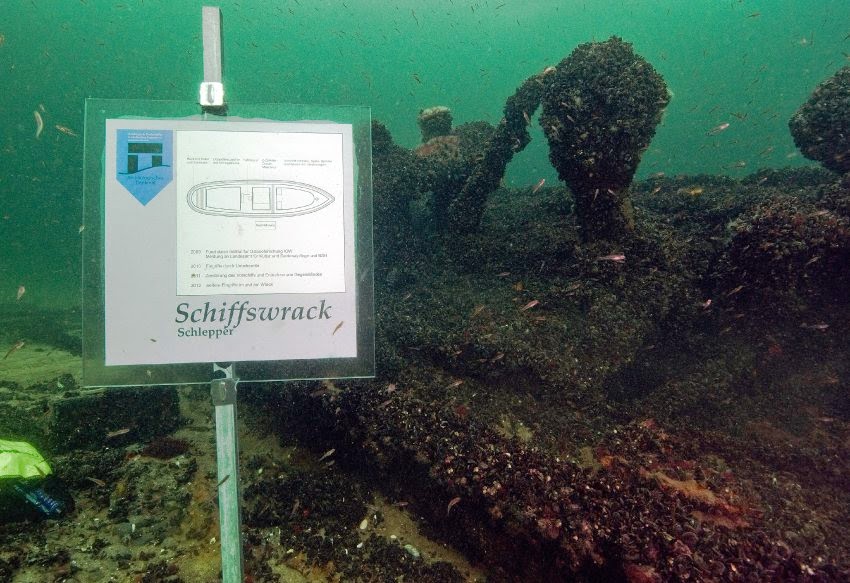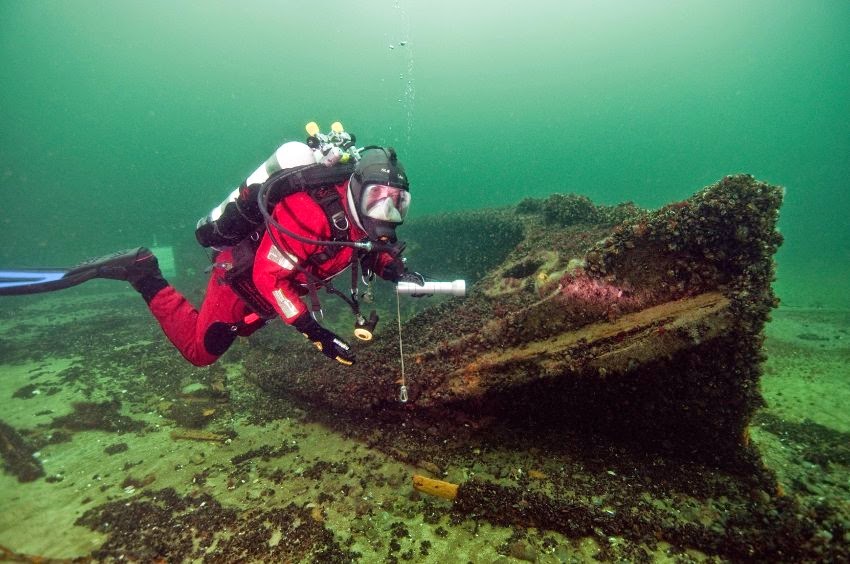 [Image: As if a lighter-than-air geometric fluid became temporarily frozen between two gateways of masonry, it’s just a bridge over the Norderelbe in Hamburg, Germany; photograph by Georg Koppmann (1888) from the collection of the Hamburg Museum, via Hamburger Architektur Sommer 2015, as spotted by Wassmann Foundation].
[Image: As if a lighter-than-air geometric fluid became temporarily frozen between two gateways of masonry, it’s just a bridge over the Norderelbe in Hamburg, Germany; photograph by Georg Koppmann (1888) from the collection of the Hamburg Museum, via Hamburger Architektur Sommer 2015, as spotted by Wassmann Foundation].
Tag: Germany
Amidst the Ruins of Military Replicas
 [Image: The Atlantic Wall at Hankley Common, Surrey, UK; Instagram by BLDGBLOG].
[Image: The Atlantic Wall at Hankley Common, Surrey, UK; Instagram by BLDGBLOG].
After blogging two years ago about the ruins of a simulated fragment of the WWII Atlantic Wall—the notorious Nazi coastal defensive system—now slowly crumbling in the woods of Surrey, I finally had an opportunity to go hike it in person with my wife and in-laws.
 [Image: The Atlantic Wall at Hankley Common, Surrey, UK; Instagram by BLDGBLOG].
[Image: The Atlantic Wall at Hankley Common, Surrey, UK; Instagram by BLDGBLOG].
The ruins themselves are both larger than you’d expect and quite compact, forming a ridge of lichen-covered concrete, jagged with rebar, nearly hidden in the vegetation.
A Dutch family was also there climbing over the ruins, and as we headed slightly further up the hillside into the trees smaller test-obstacles emerged, including “dragon’s teeth” and monolithic cuboids of stained concrete.
 [Image: The Atlantic Wall at Hankley Common, Surrey, UK; Instagram by BLDGBLOG].
[Image: The Atlantic Wall at Hankley Common, Surrey, UK; Instagram by BLDGBLOG].
We arrived during a live Ministry of Defence training exercise, with soldiers wandering out across the terrain, speaking to one another on radio headsets, their movements interrupted here and there by Sunday hikers out for an afternoon stroll.
 [Image: A soldier at Hankley Common, Surrey, UK; Instagram by BLDGBLOG].
[Image: A soldier at Hankley Common, Surrey, UK; Instagram by BLDGBLOG].
This led to the surreal scene of seeing fully outfitted military figures crouched down behind shrubbery, holding machine guns, while kids, their dogs, and their grandparents noisily ambled by. It felt like some sort of stage play gone wrong.
 [Image: Hiking at Hankley Common, Surrey, UK; Instagram by BLDGBLOG].
[Image: Hiking at Hankley Common, Surrey, UK; Instagram by BLDGBLOG].
Then the soldiers disappeared again over the next ridge and we were left looking out over an empty landscape of heather and gorse, the ruins now behind us somewhere in the thicket waiting for next weekend’s hikers to come by.
Please Don’t Take My Photochrome
 [Image: The Ghent Gate, Bruges, Belgium; via Library of Congress].
[Image: The Ghent Gate, Bruges, Belgium; via Library of Congress].
It’s easy to lose time clicking through the Library of Congress photochrome—or photochrom—collection.
 [Image: St. Croix Gate, Bruges, Belgium; via Library of Congress].
[Image: St. Croix Gate, Bruges, Belgium; via Library of Congress].
Each image has a strangely volumetric beauty, enhanced by subtle depths of shade, that results from a development and printing process that also produced these otherworldly intensities of color.
 [Image: Sevigne Gate, Bordeaux, France; via Library of Congress].
[Image: Sevigne Gate, Bordeaux, France; via Library of Congress].
 [Image: Narrow Streets, Naples, Italy; via Library of Congress].
[Image: Narrow Streets, Naples, Italy; via Library of Congress].
Houses, castles, mountains, rivers, ruins.
 [Image: The valley of Chamonix from the Aiguille du Floria, Chamonix Valley, France; via Library of Congress].
[Image: The valley of Chamonix from the Aiguille du Floria, Chamonix Valley, France; via Library of Congress].
Utterly mundane subjects seem hallucinatory, like stills from an old animated film—
 [Image: Old house in Rue St. Martin, Bayeux, France; via Library of Congress].
[Image: Old house in Rue St. Martin, Bayeux, France; via Library of Congress].
—or even hand-colored illustrations from a fairy tale.
 [Image: The Rabot Gate, Ghent, Belgium; via Library of Congress].
[Image: The Rabot Gate, Ghent, Belgium; via Library of Congress].
Many look like paintings.
 [Image: The cathedral, Carthage, Tunisia; via Library of Congress].
[Image: The cathedral, Carthage, Tunisia; via Library of Congress].
Purely in the interests of weekend eye-candy, I just thought I’d post a bunch here.
 [Image: Sidi-Ben-Ziad, Tunis, Tunisia; via Library of Congress].
[Image: Sidi-Ben-Ziad, Tunis, Tunisia; via Library of Congress].
I could look at these all day—these old streets and roofscapes, honey-colored rocks and even brilliant white robes glowing with sunlight.
 [Image: Tresure Street, Tunis, Tunisia; via Library of Congress].
[Image: Tresure Street, Tunis, Tunisia; via Library of Congress].
 [Image: Mosque of St. Catherine, Tunis, Tunisia; via Library of Congress].
[Image: Mosque of St. Catherine, Tunis, Tunisia; via Library of Congress].
 [Image: Red Sea street, Algiers, Algeria; via Library of Congress].
[Image: Red Sea street, Algiers, Algeria; via Library of Congress].
It’s also interesting to watch as small moments of modernity pop-up in the landscape, like funiculars or—in other images not included here—cable railways, train stations, and steamships.
 [Image: Cable railway, Marseille, France; via Library of Congress].
[Image: Cable railway, Marseille, France; via Library of Congress].
In other cases, it’s just the pure bulk of masonry and its interaction with sunlight that remains so visually compelling, where looking at the city almost meant looking at a geological formation, an artificial mountain chain that you knew was filled with rooms and hallways waiting to be explored.
 [Image: Abbey from the ramparts, Mont St. Michel, France; via Library of Congress].
[Image: Abbey from the ramparts, Mont St. Michel, France; via Library of Congress].
 [Image: New Gate, Grasse, France; via Library of Congress].
[Image: New Gate, Grasse, France; via Library of Congress].
 [Image: Basilica Fourviere, Lyons, France; via Library of Congress].
[Image: Basilica Fourviere, Lyons, France; via Library of Congress].
Finally, these old, looming roof profiles from buildings in Germany are spectacular.
Architects and engineers today should spend more time thinking about roofs, as spaces that can be inhabited, not merely as minimal surfaces used for no other purpose than to cover another space.
Roofs should be labyrinths you can walk through and get lost within. Roofs should have dimension; they should have windows and rooms. They should be spaces in their own right, not just lines where other spaces end.
 [Image: Knockenhauer Amtshaus, Hildesheim, Hanover, Germany; via Library of Congress].
[Image: Knockenhauer Amtshaus, Hildesheim, Hanover, Germany; via Library of Congress].
 [Image: The Sack House, Brunswick (i.e., Braunschweig), Germany; via Library of Congress].
[Image: The Sack House, Brunswick (i.e., Braunschweig), Germany; via Library of Congress].
 [Image: Leibnitz House, Hanover, Germany; via Library of Congress].
[Image: Leibnitz House, Hanover, Germany; via Library of Congress].
 [Image: Das Rattenfangerhaus, Hameln, Hanover, Germany; via Library of Congress].
[Image: Das Rattenfangerhaus, Hameln, Hanover, Germany; via Library of Congress].
 [Image: Brusttuch, Goslar, Hartz, Germany; via Library of Congress].
[Image: Brusttuch, Goslar, Hartz, Germany; via Library of Congress].
 [Image: Holstengate, Lübeck, Germany; via Library of Congress].
[Image: Holstengate, Lübeck, Germany; via Library of Congress].
In any case, last but not least, here are some still-standing “bridge houses” in Bad Kreuznach, Germany.
 [Image: Bridge houses, Kreuznach (i.e., Bad Kreuznach), Nahethal, Rhenish Prussia, Germany; via Library of Congress].
[Image: Bridge houses, Kreuznach (i.e., Bad Kreuznach), Nahethal, Rhenish Prussia, Germany; via Library of Congress].
See many, many, many more photochrom prints over at the Library of Congress.
The Mirror War and the Light Brigade
 [Image: A cosmetically touched-up view of villages being set alight by mirrors; view slightly larger. From Deliciae physico (1636) by Daniel Schwenter].
[Image: A cosmetically touched-up view of villages being set alight by mirrors; view slightly larger. From Deliciae physico (1636) by Daniel Schwenter].
Perhaps you remember the Austrian village of Rattenberg, so thoroughly hidden in the mountain shadows every winter that it installed a huge system of mirrors to bring the sun back in. The town of Rjukan, Norway, recently experimented with the same thing.
“High on the mountain opposite,” the Guardian reported back in 2013, “450 metres above the town, three large, solar-powered, computer-controlled mirrors steadily track the movement of the sun across the sky, reflecting its rays down on to the square and bathing it in bright sunlight.”
A far more sinister version of this exact sort of system was illustrated in a German book called Deliciae physico, published back in 1636, by Daniel Schwenter.
There, a woodcut shows a kind of reflective super-weapon mounted atop pillars, made of concave mirrors and magnifying lenses, setting fire to two distant buildings simultaneously the way a bumbling child might torture ants.
 [Image: The full original page; view larger. From Deliciae physico (1636) by Daniel Schwenter].
[Image: The full original page; view larger. From Deliciae physico (1636) by Daniel Schwenter].
Interestingly, this Apollonian death ray—a frighteningly literal light brigade—is presented in the book’s much larger context of telescopes, astronomy, and other optical devices, including distorting mirrors and cameras obscura.
Check out all 650 pages of the book here, courtesy of the U.S. Library of Congress, including some very cool images.
(Originally spotted via the excellent Twitter feed, @HistAstro).
The Museum At The Bottom Of The Sea
 [Image: Photo by Martin Siegel/Society of Maritime Archaeology, via Der Spiegel].
[Image: Photo by Martin Siegel/Society of Maritime Archaeology, via Der Spiegel].
In 2012, German archaeologists began posting interpretive signs underwater, marking shipwrecks and even crashed airplanes at the bottom of the Baltic Sea as if they are in a museum, in order to make it clear to potential vandals, reckless tourists, and amateur collectors that these are culturally important sites, worthy of preservation.
“Alarmed at the looting of historically valuable shipwrecks in the Baltic Sea,” Der Spiegel reported at the time, “German archaeologists have started attaching underwater signs designating them as protected monuments. Hobby divers and trophy hunters are damaging a precious maritime legacy stretching back thousands of years, they warn.”
The sunken ship seen in the above image, for example, is just one of “some 1,500 marine monuments strewn across the seabed along the coast. The area has a wealth of well-preserved shipwrecks, lost cargo planes and even ancient settlements submerged through subsidence and rising water levels.” That these can be described as monuments is very important: they are not mere wreckage, scattered over the seabed, but artifacts on display for those who can reach them.
 [Image: Photo by Martin Siegel/Society of Maritime Archaeology, via Der Spiegel].
[Image: Photo by Martin Siegel/Society of Maritime Archaeology, via Der Spiegel].
The effect is strangely evocative, as if an architectural experiment has been going on beneath the waves of the Baltic Sea for the last few years, in which a museum, entirely without walls and seemingly with only very few visitors, has been secretly installed and constructed. It is a distributed, nonlinear museum of European ruins barely visible in the rising sea.
What’s so interesting from an architectural standpoint, however, is how a group of signs such as these can have such a huge narrative and spatial effect, as if you’ve entered some sort of undefined volumetric space without walls, hidden in the water all around you, a kind of invisible cultural institution stocked with objects that only you and your fellow divers, at that exact moment, can even see.
In fact, it makes me curious how the (totally brilliant and BLDGBLOG-supported) idea of creating a new National Park on the moon might work—and, more to the point, what such a park would really look like. Do we just post a few signs on the lunar surface indicating that historically important artifacts are present up ahead, or do we actually construct some sort of “museum” space there that would more adequately sustain an aura of cultural history?
Either way, it’s both hilarious and deeply strange that we could begin to experiment with what such a park might look like using—of all things—shipwrecks at the bottom of the Baltic Sea, and that German archaeologists, randomly posting cheap signs on the seabed, might have anticipated future strategies of historic preservation in otherwise deeply unearthly situations.
